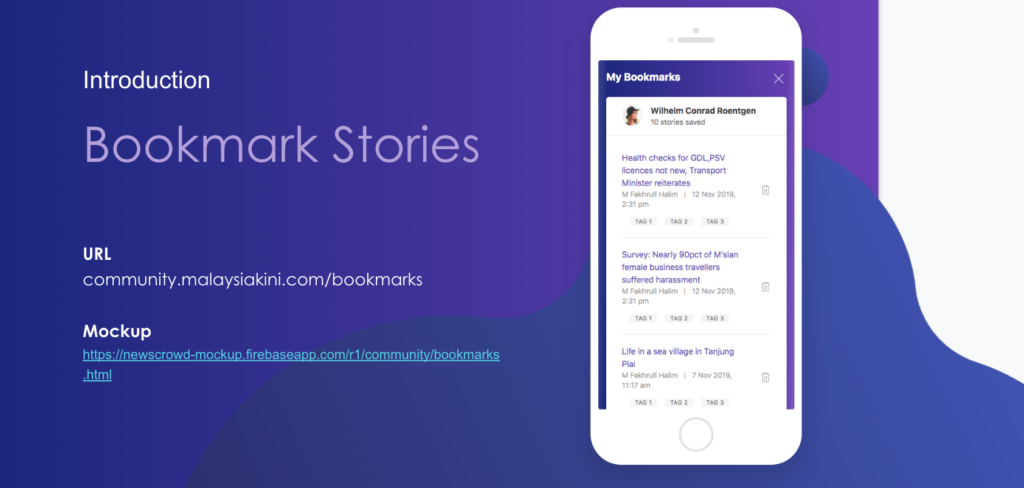Newsroom overview
A national trilingual news organization focused on local news and politics
Selangor, Malaysia
1999
2019
5 million
20,792*
46 percent
Malaysiakini launched a subscription in 2002, making it one of the first newsrooms in Asia to adopt an audience revenue model. In 2019, Malaysiakini introduced a membership program as a supplement to its subscription because subscription growth had stagnated and readers wanted a deeper relationship with the organization. The membership is an optional add-on, allowing subscribers to opt-in if they want (at no additional cost), or remain subscribers.
Malaysiakini chose this blended model, rather than moving to membership alone, because of the political climate in Malaysia. Government attacks on the press are frequent, and Malaysiakini knew some readers would be afraid of calling themselves a “member” of Malaysiakini.
“There is a wisdom in not formalizing [our membership program]. We can use the term ‘members’ informally for now. But everything that’s in writing says subscribers, even our invoices because using the term ‘member’ might make the government target them,” Chief Membership Officer Lynn D’Cruz said.
*This is the number of subscribers. Malaysiakini was unable to provide the number of subscribers who opted in to membership.
Why this is important
The Malaysian government keeps close tabs on journalists by threatening to revoke publishing licenses and suing individuals and organizations – including Malaysiakini on several occasions, most recently in June 2020 over user comments on the site. That made readers fearful of being publicly associated with the organization.
Because of that fear among readers that they might become targets for being “members” of Malaysiakini, the organization felt it was important to allow readers to remain publicly identified as subscribers. Readers only get invitations to become a member after they subscribe.
The blended model allows Malaysiakini to offer options for both those who want to support and read Malaysiakini without being associated with it and those who want to engage more deeply (but still want to keep a low profile while doing so).
MPP has often been asked what membership looks like in repressive media environments. Malaysiakini’s approach offers one way that news organizations can quietly support the engagement typical to membership models while not exposing their supporters to risk.
In addition, blended revenue models are on the rise, raising many questions about how, exactly, two models can coexist in the same organization. This is an example.
What they did
Malaysiakini has had a subscription service since 2002, but launched their membership program in November 2019.
They began the process of designing the membership program with a survey to subscribers asking them why they remain subscribers (most said it was because of their loyalty to Malaysiakini) and what they hope to see in the future. They received a couple thousand replies. The survey showed that the top two requests were a newsletter and early access to news reports (the latter of which is still in development).
In response, Malaysiakini introduced two membership products:
Nifty Notes newsletter: All subscribers are automatically added to the mailing list for this weekly newsletter, although they can opt out at any time. This newsletter is available to non-subscribers, too, as a loyalty-building product that might encourage them to become paying subscribers down the line.
Kini Community: An online community available to subscribers who opt-in to the membership program. Members of Kini Community are allowed to bookmark stories, follow and like comments by other members in the community, and bid for stories they want Malaysiakini to cover next. This was developed in response to readers who expressed interest in having a deeper relationship with Malaysiakini.

Although the journalism industry is trending away from allowing anonymous commenters, Malaysiakini opted to allow subscribers to comment anonymously to protect them from any retribution by the Malaysian government.
Malaysiakini has had to handle commenting carefully amid government pressure, particularly since the government sued Malaysiakini over five anonymous comments left on the site.
Malaysiakini’s commenting policy reads:
All comments are linked to your Malaysiakini subscription profile which we reserve the right to disclose to law enforcement agencies should they require it for valid purposes. In the past, Malaysiakini had refused to divulge the identity of our contributors, resulting in police raids and computers seized. We will continue this policy. However, there may be exceptions to this.
At the same time, Malaysiakini incentivizes Kini Community members to use their real names by giving them points for doing so. The points are akin to currency in the Kini Community, and members accumulate points by purchasing them, leaving comments, or using their real names. Points allow them to like others’ comments.
The results
Although Malaysiakini declined to provide numbers, they say that almost one-third of their subscribers have joined since November 2019, when they launched the membership add-on and more than half of their total subscribers opted into membership.
However since the Malaysian government filed charges against the publication in June 2020, commenting on site and engagement on Kini Community has dropped, partially because of a dip in enthusiasm and partially because Malaysiakini has also reduced the number of stories it allows comments on. It no longer allows comments on the story about the ongoing trial, said CEO Premesh Chandran.
Subscribers have expressed concern that Malaysiakini will hand over their personal information to the Malaysian police, despite the fact that Malaysiakini has made clear in its commenting policy that it will not do this unless a commenter is “in clear breach of the law” – even if refusing means risking another raid of its office. Malaysiakini has had to be very clear with commenters what they can and can’t protect commenters from.
“We actually warn our [commenters] that they are responsible for their own comments, and we will hand over their personal details if required by the police. This also ensures that our readers are more responsible for their comments on Malaysiakini,” Chandran wrote to MPP.
What they learned
Having a blended model allowed Malaysians to support Malaysiakini whatever way felt safest. It was crucial to offer readers the option to remain a transactional subscriber relationship, or to opt-in to membership as well. This allowed Malaysiakini to continue to receive financial support from both types of readers. “They believe that Malaysiakini provides truthful information and this is what they’re supporting. They want access to the truth,” D’Cruz said.
However, community building is incredibly hard when participating in the community feels risky. Malaysiakini has seen a steep decline in engagement since charges were filed against the publication. They’re experimenting with incentivizing Kini Community members to use their real names, but against the backdrop of the trial, it’s unclear if that will work.
Key takeaways and cautionary notes
If you’re operating in an environment with limited press freedom, make sure your supporters feel safe. In a country like Malaysia, where government persecution of media is strong, the number of people who want to publicize that they support a news organization targeted by the government is likely much smaller than the number of people who want accurate information but want to keep a low profile. As you choose and design your audience revenue model, it’s important to keep in mind not just what you need, but what will make your potential supporters feel safe offering their support.
Having a blended model requires clear communication. Having two revenue and engagement models coexist in the same organization requires exceptionally clear communication with your audience members. Any confusion could lead to trouble gaining both subscribers and members. You should strive to make it easy for them to understand the difference, as well as which best suits their needs.
Other resources
- GIJN, article: “After 20 years fighting for democracy, what’s next for Malaysiakini”
- Splice Beta, presentation: “How I became a membership engagement leader”
- WAN-IFRA, presentation: Malaysiakini subscription-membership hybrid


